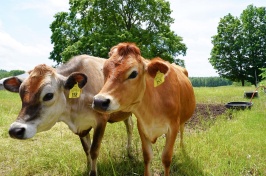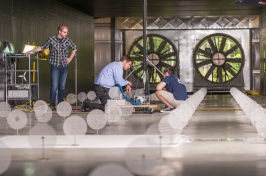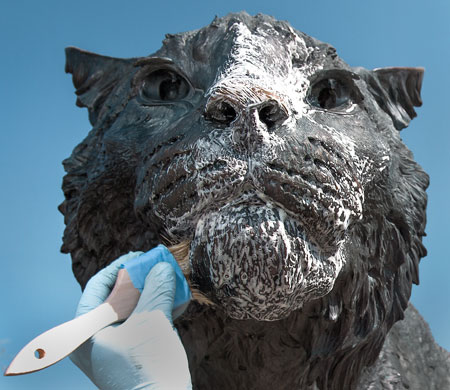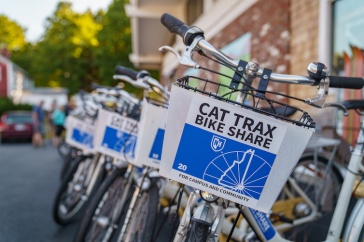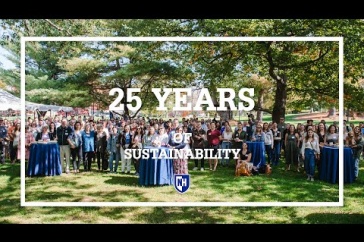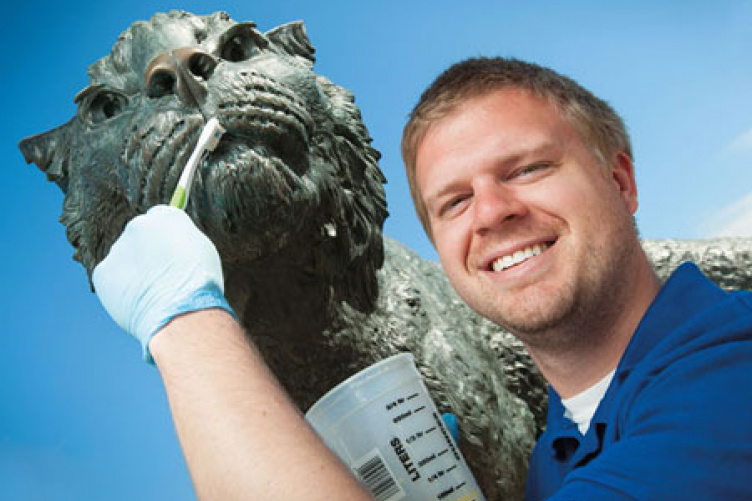
Artist, sculptor, and professional restorer Jameson Copp '09 won the assignment of giving the wildcat sculpture a much needed spring cleaning. When he's finished, the bronze icon will be good for 100,000 more lucky pats.
With bronze sculptures, green is not always good. Photo by Perry Smith, UNH Photographic Services.
On a busy Friday afternoon, Jameson Copp ’09 is studying the wildcat sculpture in front of the Whittemore Center. It’s time for the cat to get a little cleaning, restoration and upkeep, and Copp, who graduated from UNH with a fine arts degree in sculpture, is just the guy to take on the task.
His tools of the trade? Q-tips, toothbrushes, soft cloths and three different detergents.
“It’s all about preserving the work for the future in its current state,” said Copp, who has been hired by the university to complete a conservation of the campus icon to keep it looking good for decades to come. “You want to maintain the current patina so it doesn’t age and turn green and milky. Especially in this case, where it’s become such an important symbol for UNH.”
When it was unveiled during Homecoming weekend in 2006, the wildcat sculpture was the first piece of commissioned artwork on the UNH campus. Since then, it’s become a part of campus life, especially since the new tradition of “pat the cat” began. Students give the bronze statue a little pat for good luck before a big game or final exam.
Since graduating from UNH, Copp has been working as an apprentice at an art restoration company in Beverly, Mass., and also teaches a ceramics class at a private pottery studio. That’s all in addition to creating his own work from an artist space in Somerville, Mass. His apprenticeship has focused mainly on painting restoration with just a few sculpture pieces. That experience, combined with Copp’s own work as a sculptor, made him the ideal candidate for the conservation project.
|
After a brush and close shave, the wildcat sculpture should be as good as new. Photo by Mike Ross, UNH Photographic Services. |
Even though the statue is just seven years old, it’s already starting to show signs of wear. Copp pointed out some white streaks near the cat’s nose and mouth as evidence of the oxidizing caused by the elements affecting the outdoor sculpture.
His first step in cleaning was to test each of the detergents he brought on the affected areas as test spots to see which was the most effective without doing any damage. Once he found the right detergent, he applied the material to the sculpture by working it into the grooves of the cat’s coat. The process finished with two coats of wax to protect the sculpture.
Copp stays in touch with his some of his UNH professors, who had encouraged him to submit a proposal for the project. Working to preserve the UNH icon he saw installed as an undergraduate has brought Copp full circle, indeed.
“I got to see all the steps to get it here,” said Copp, remembering that sculptor Matthew Gray Palmer built the bronze statue in phases and then welded it together.
As an artist and sculptor himself, Copp says he can appreciate the importance of the wildcat. “It’s nice to see public art as a connector to the university” for so many students who pose for pictures in front of the statue, or take part in the pat the cat tradition at the beginning of their freshman year. “It’s also great for the university to see what art can bring to the community. It can build long-lasting ties with students.”
Fast Facts: Wildcat Sculpture
- Created by Matthew Gray Palmer, of Friday Harbor, Washington.
- Chosen by a committee of UNH staff, faculty, alumni and parents, as well as professional artists, Palmer was among 40 artists who submitted proposals for the project.
- It took Palmer about 10 months to create the cat.
- Installed on Sept. 20, 2006.
- The $160,000 statue was funded entirely by private gifts, including support from the Edward ’42H and Selma ’42 Bacon Simon Fund, many alumni donors, the UNH Alumni Association, and the UNH Parents Association.
- It was Palmer’s hope that people would reach out and pat the cat. "The public work I do gets an artistic expression out where people can touch it, feel the patterns and put their arms around it," he said.
Why is the UNH Mascot a Wildcat?
The wildcat was voted in as the official college mascot in February 4, 1926. The Durham Bulls – a name given to the varsity hockey team by the media – was a close runner-up, but the wildcat won out in the final count. Huskies, eagles and even a unicorn were among the contenders. The N. H. Club went on record in The New Hampshire prior to the election as favoring the wildcat for these reasons:
- The wildcat is small and aggressive – like New Hampshire.
- The actions of the wildcat are more symbolic of a New Hampshire team on the field than those of the sluggish bull.
Originally published by:
UNH Today
Written by Michelle Morrissey ’97
-
Written By:
Staff writer | Communications and Public Affairs






























